STELIA Aerospace participates in Dassault Aviation’s high-end business jet development
Ultra-long range business jet will feature four aerostructure sub-assemblies for the aircraft’s central fuselage section and pilot seats provided by STELIA, Rolls Royce engines and carbon fiber wings.

Photo Credit: Dassault Aviation
(Toulouse, France) announced on May 6 that it is collaborating with (Paris, France) to develop the Falcon 10X business jet, which features a newly designed carbon fiber wing. According to STELIA Aerospace, this new contract confirms the company’s excellency and competitiveness in the field of aerostructures and pilot seats, on the high-end business aviation segment.
Specifically, the company is to focus on two projects regarding the Falcon 10X:
- Developing and providing four aerostructure sub-assemblies for the aircraft’s central fuselage section (lower shell, aft fuel tank, upper fuselage section and emergency exit door). These sub-assemblies will be developed by STELIA Aerospace’s teams following new innovative processes, based on total digital continuity, from design to mass production.
- Developing and manufacturing new generation pilot and co-pilot seats, aimed at improving the comfort and rest of the pilots.
“In the name of STELIA Aerospace and our teams, I am proud to see our company participate in Dassault Aviation’s new business jet program, the Falcon 10X,” says Cédric Gautier, CEO of STELIA Aerospace. “Both projects under our responsibility will be developed in partnership with our customer, building on our international industrial footprint, highlighting the know-how and competitiveness of our plants in France and in Tunisia. This is excellent news, especially in this time when the aeronautical industry is facing an unprecedented crisis.”
Related Content
-
McLaren develops aerospace-inspired ART method for volume composite super car engineering
Automated rapid tape (ART) technique, already deployed at the MCTC and to be used for future McLaren models, is capable of producing lighter, stiffer and stronger carbon fiber structures with less waste.
-
“Structured air” TPS safeguards composite structures
Powered by an 85% air/15% pure polyimide aerogel, Blueshift’s novel material system protects structures during transient thermal events from -200°C to beyond 2400°C for rockets, battery boxes and more.
-
Co-molding SMC with braided glass fiber demonstrates truck bed potential
Prepreg co-molding compound by IDI Composites International and A&P Technology enables new geometries and levels of strength and resiliency for automotive, mobility.



